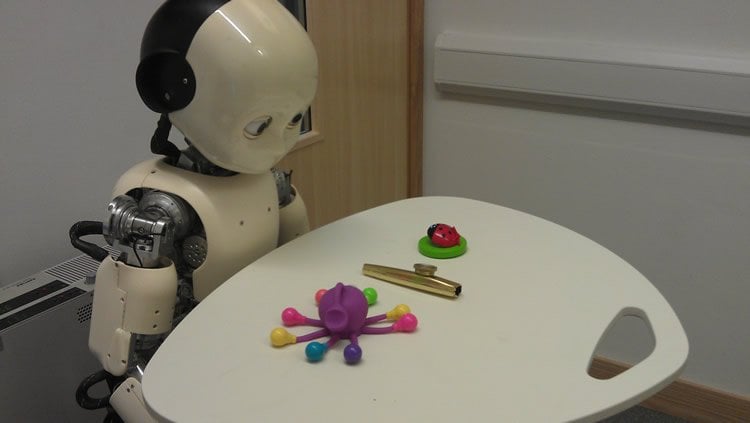Summary: A robotic system has enabled researchers to better understand how young children learn words.
Source: Lancaster University.
Children learn new words using the same method as robots according to psychologists.
This suggests that early learning is based not on conscious thought but on an automatic ability to associate objects which enables babies to quickly make sense of their environment.
Dr Katie Twomey from Lancaster University, with Dr Jessica Horst from Sussex University, Dr Anthony Morse and Professor Angelo Cangelosi from Plymouth wanted to find out how young children learn new words for the first time. They programmed a humanoid robot called iCub designed to have similar proportions to a three year old child, using simple software which enabled the robot to hear words through a microphone and see with a camera. They trained it to point at new objects to identify them in order to solve the mystery of how young children learn new words.
Dr Twomey said: “We know that two-year-old children can work out the meaning of a new word based on words they already know. That is, our toddler can work out that the new word “giraffe” refers to a new toy, when they can also see two others, called “duck” and “rabbit”.”
It is thought that toddlers achieve this through a strategy known as “mutual exclusivity” where they use a process of elimination to work out that because the brown toy is called “rabbit”, and the yellow toy is called “duck”, then the orange toy must be “giraffe”.

What the researchers found is that the robot learned in exactly the same way when shown several familiar toys and one brand new toy.
Dr Twomey said: “This new study shows that mutual exclusivity behaviour can be achieved with a very simple “brain” that just learns associations between words and objects. In fact, intelligent as iCub seems, it actually can’t say to itself “I know that the brown toy is a rabbit, and I know that that the yellow toy is a duck, so this new toy must be giraffe”, because its software is too simple.
“This suggests that at least some aspects of early learning are based on an astonishingly powerful association making ability which allows babies and toddlers to rapidly absorb information from the very complicated learning environment.”
Source: Lancaster University
Image Source: This NeuroscienceNews.com image is credited to Lancaster University.
Original Research: Full open access research for “Children’s referent selection and word learning: Insights from a developmental robotic system” by Katherine E. Twomey, Anthony F. Morse, Angelo Cangelosi, and Jessica S. Horst in Interaction Studies. Published online September 26 2016 doi:10.1075/is.17.1.05two
[cbtabs][cbtab title=”MLA”]Lancaster University. “Toddler Robots Help Solve How Children Learn.” NeuroscienceNews. NeuroscienceNews, 29 November 2016.
<https://neurosciencenews.com/learning-toddler-robot-5626/>.[/cbtab][cbtab title=”APA”]Lancaster University. (2016, November 29). Toddler Robots Help Solve How Children Learn. NeuroscienceNews. Retrieved November 29, 2016 from https://neurosciencenews.com/learning-toddler-robot-5626/[/cbtab][cbtab title=”Chicago”]Lancaster University. “Toddler Robots Help Solve How Children Learn.” https://neurosciencenews.com/learning-toddler-robot-5626/ (accessed November 29, 2016).[/cbtab][/cbtabs]
Abstract
Children’s referent selection and word learning: Insights from a developmental robotic system
It is well-established that toddlers can correctly select a novel referent from an ambiguous array in response to a novel label. There is also a growing consensus that robust word learning requires repeated label-object encounters. However, the effect of the context in which a novel object is encountered is less well-understood. We present two embodied neural network replications of recent empirical tasks, which demonstrated that the context in which a target object is encountered is fundamental to referent selection and word learning. Our model offers an explicit account of the bottom-up associative and embodied mechanisms which could support children’s early word learning and emphasises the importance of viewing behaviour as the interaction of learning at multiple timescales.
“Children’s referent selection and word learning: Insights from a developmental robotic system” by Katherine E. Twomey, Anthony F. Morse, Angelo Cangelosi, and Jessica S. Horst in Interaction Studies. Published online September 26 2016 doi:10.1075/is.17.1.05two






